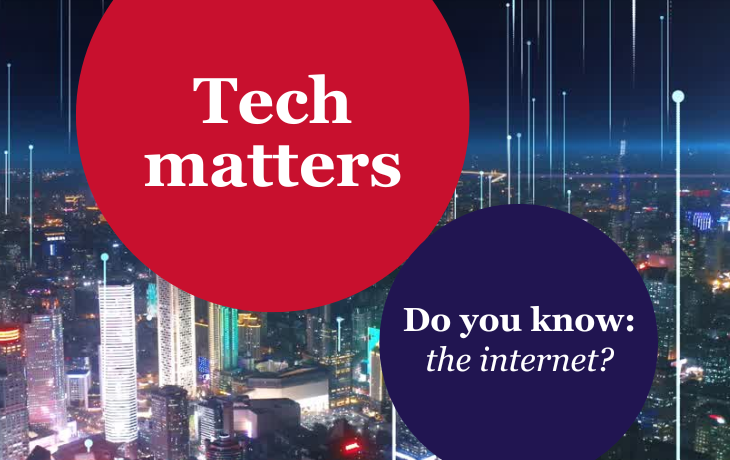How the internet will keep up with exploding demand
It is easy to take the internet for granted. We expect it to work everywhere and instantly. But behind every video call, artificial intelligence (AI) query and Internet of Things (IoT) ping lies an intricate and ever-evolving web of physical infrastructure. As demand for more bandwidth, low latency (i.e. quick response), resilience and global coverage continues to surge, the need for investment and innovation across internet infrastructure is more urgent than ever. There are four key trends shaping the future of internet infrastructure: faster routes, more routes, more devices and more data centres.
Faster routes – fibre, intelligent networking and the promise of 6G
In order to meet increased demand for more advanced services, the push towards faster, higher-capacity networks is relentless. Fibre is king when it comes to speed and reliability, although some technology options may be more efficient (i.e. affordable, from a cost perspective) in certain use cases. The next generation of fibre deployments – whether in core networks or the final mile – will be increasingly advanced to enable flexibility and innovation. Fibre already accounts for over 70% of all fixed broadband connections, and this share is expected to surpass 80% in the coming years.
In parallel, wireless networks are undergoing their own transformation. While 5G is still rolling out globally, eyes are already turning towards 6G. Promising ultra-low latency and terabit-per-second speeds, 6G could unlock new use cases – immersive augmented/virtual reality (AR/VR), tactile internet and real-time digital twins – that demand a step change in both mobile access and the underlying fixed infrastructure.
More routes – satellites, submarine cables and terrestrial redundancy
Future internet infrastructure will not just be faster, it will be more resilient and ubiquitous. A significant part of that resilience will come from creating more diverse paths for data to travel. Low-Earth orbit (LEO) satellite constellations are now a credible complement to terrestrial networks. Their proliferation extends the internet’s reach to remote, underserved or disaster-hit areas, and provides additional routing diversity in congested regions.
Meanwhile, submarine cable investment is booming with a new wave of projects, many backed or initiated by hyperscalers (i.e. large tech companies) and reshaping global connectivity. These systems are increasingly routed along previously underutilised paths, offering geopolitical and technical resilience in the face of increased accidental or deliberate cable cuts.
On land, new terrestrial fibre routes are emerging. Whether to bypass congested urban cores, enable access for land-locked countries, connect rural data centres, or build edge computing capacity in Tier 2 and Tier 3 cities, these routes will be key to maintaining low-latency performance and regional network diversity.
More devices – billions of things, not just people
The next phase of internet growth is not only about connecting people. It is about connecting things. The number of IoT devices worldwide is expected to exceed 7 billion in the next few years, spanning everything from industrial sensors to connected vehicles and smart appliances. These devices bring new internet traffic patterns, with more frequent bursts of small pieces of data, and place new demands on the network in terms of reliability, security and localisation.
5G (and in the future, 6G) will be instrumental in handling this shift, especially for ultra-reliable, low-latency use cases like autonomous transport or remote surgery. The need to process and act on data closer to the source will drive greater edge compute deployments, often in compact, distributed facilities closer to population centres or industrial hubs.
More data centres – the physical home of the internet
All of this traffic – generated by new services and more devices, routed across new paths, at ever-higher speeds – must ultimately be processed and stored somewhere. Enter the data centre. We are witnessing explosive growth in a growing variety of data centres:
- Interconnection facilities, where networks meet and exchange traffic. These are becoming more distributed, bringing peering and content caches closer to users.
- Hyperscale data-centre campuses for large tech companies, which continue to grow to bring cloud and internet-enabled services close to regional clusters.
- Edge data centres that provide localised compute and storage for latency-sensitive applications such as IoT services.
- AI-focused data centres, increasingly designed around high-density compute, advanced cooling and specialised network fabrics to support training of models, often in more remote but cost-efficient locations.
The compute in these data centres generates significant heat, requiring massive amounts of energy for cooling. As a result, sustainability is no longer a ‘nice to have’ – it is a prerequisite. As operators push boundaries, we are seeing bold experimental deployments like submarine and floating data centres – aimed at reducing cooling costs and bringing compute closer to coastal populations. There is also a rising wave of interest in small modular reactors (SMRs) as a potential clean, high-density energy source for future facilities.
A converging future
While each of these trends – faster routes, more routes, more devices and more data centres – can be tracked independently, they are converging in interesting ways. LEO satellites will feed into terrestrial fibre backbones. Edge data centres will serve the data needs of billions of IoT devices. AI workloads will stretch the limits of both fibre capacity and data-centre design. In short, the infrastructure of the internet is no longer merely a technical enabler – it is a strategic differentiator.

Do you know the internet?
Author

